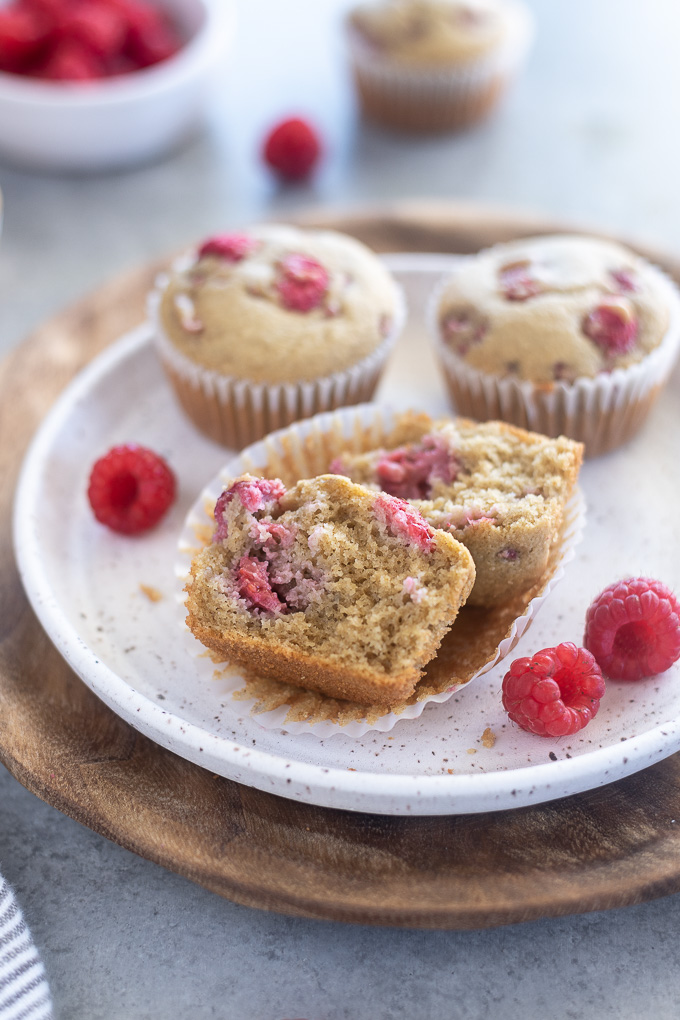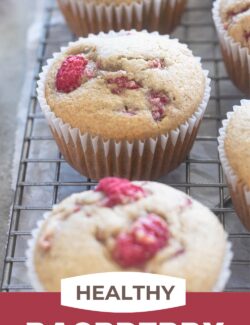Healthy Raspberry Muffins
These Raspberry Muffins are so tender and fluffy that you’d never know they’re healthy! They’re dairy and gluten-free with no refined sugar, and are packed with wholesome ingredients. They come together in just one bowl and they’re freezer friendly!

Muffins have been one of my favorite bakery treats for as long as I can remember, but I rarely order them out anymore as most are more like dessert than breakfast.
Bakery style muffins are laden with as much fat and sugar than a slice of cake, and have no nutritional value whatsoever.
I’ve made it my mission over the years to create muffin recipes that include wholesome, real food ingredients, minimal sugar and oil, and still taste absolutely delicious.
These Healthy Raspberry Muffins check all of the boxes. They’re tender and fluffy, mildly sweet with the flavors of maple syrup and vanilla, and they’re studded with juicy raspberries.
This recipe was adapted from my blueberry oatmeal muffins, which have a light, tender texture that I adore. They’re still surprisingly satisfying thanks to whole grain oats and almond flour.
The tart sweet raspberries truly make these muffins special, and I can’t seem to bake them enough!

Why you’ll love this recipe:
- These raspberry muffins are tender, fluffy, mildly sweet and packed with wholesome, real food ingredients.
- They’re dairy and gluten-free with no refined sugar or oils.
- They come together in about 10 minutes in just one bowl.
- They’re a great meal prep breakfast option and they’re freezer friendly.
Recipe ingredients
This raspberry muffin recipe includes the following ingredients, and a few can be customized based on what you already have on hand.

Ingredient notes
- Raspberries. Use fresh or frozen raspberries for these raspberry muffins. If using frozen raspberries, there’s no need to thaw them first.
- Almond flour. For best results, use finely ground almond flour. Do not substitute with almond meal as it contains the skin of the almonds and will lend a grainy texture.
- Oat flour. You can use store bought, or find out how to make oat flour with oats that you already have in your pantry.
- Eggs. The eggs are essential for binding the ingredients together. This recipe has not been tested with an egg replacement.
- Oil. The oil provides moisture and a tender a crumb. I prefer to use unrefined oils such as olive oil, avocado oil or coconut oil, but you can use whatever you have on hand.
- Maple syrup. Pure maple syrup adds great flavor and moisture to the muffins. It can be substituted with honey, coconut sugar or your favorite sweetener. Texture may vary slightly depending on what type of sweetener you use.
- Milk. I prefer to use unsweetened almond milk in this recipe, but you can use whatever type of dairy or non-dairy milk that you have on hand.
- Leavening. Baking powder and baking soda are essential for leavening the muffins.
- Vanilla extract. The vanilla adds depth of flavor. You can substitute it with almond or lemon extract, or omit it altogether.
How to make this raspberry muffin recipe
This raspberry muffin recipe is extremely easy to make. The batter comes together in about 10 minutes in one large mixing bowl.
Pro tip: Use finely ground almond flour for best results. Do not substitute with almond meal as it contains the skin of the almonds and will lend a grainy texture.
See the recipe card below for full instructions.

- Place the eggs, oil, maple syrup, milk and vanilla extract in a large mixing bowl and whisk well to combine.
- Add the almond flour, oat flour, baking powder, baking soda and salt and whisk until well incorporated and no lumps remain. Gently fold in the raspberries.
- Divide the batter between (12) standard muffin cups lined with paper liners.
- Bake at 350 degrees for 18-20 minutes or until golden brown and set.

FAQs
Many muffin recipes are laden with an excessive amount of fat and sugar, and are more like cake than muffins.
These raspberry muffins are packed with wholesome, real food ingredients, they’re a good source of protein and fiber, and they’re lower in sugar and carbohydrates. They contain heart healthy fats, there’s no refined sugar or oils, and they’re dairy and gluten-free.
If you are following a special diet or have health issues, be sure to talk to your doctor to find out if this recipe is right for you.
Fresh or frozen raspberries may be used in this raspberry muffin recipe. If using frozen, there’s no need to thaw them.
Store healthy raspberry muffins in an air tight container at room temperature for up to 3 days or refrigerate them for up to 1 week. If chilled, microwave for 10 seconds before enjoying if desired.
Raspberry muffins are freezer friendly. Place them in an air tight container in the freezer for up to 3 months. Thaw overnight in the refrigerator and enjoy!

Recipe variations
There are a number of different ways to change up these healthy raspberry muffins as outlined below.
- Make them lemon raspberry muffins by adding a tablespoon of lemon zest to the batter and top the muffins with a lemon glaze like the one for my lemon glazed baked donuts.
- Add 1/2 cup white chocolate or dark chocolate chips.
- Sub the almond flour with hazelnut flour, or sub the oat flour with teff or sorghum flour.
- Top the muffins with rolled oats, nuts or seeds for added texture.
- Add a teaspoon of ground cinnamon, cardamom or chai spice mix for warm spice flavor.
- Sub the raspberries with your favorite berries or chopped fruit.
Recipe notes
- Pro tip: Use finely ground almond flour for best results. Do not substitute with almond meal as it contains the skin of the almonds and will lend a grainy texture.
- If using frozen raspberries, there’s no need to thaw them.
- Store in an air tight container at room temperature for up to 3 days or in the refrigerator for up to 1 week.
- Raspberry muffins may be frozen for up to 3 months.

More healthy muffin recipes you’ll love:
- Almond flour banana blueberry muffins
- Cranberry orange muffins
- Gluten free chocolate chip muffins by Ambitious Kitchen
- Healthy banana muffins
- Healthy carrot muffins
- Healthy chocolate zucchini muffins
- Healthy morning glory muffins
- Healthy pumpkin muffins
- Healthy zucchini muffins
- Peanut butter banana muffins
Did you try this recipe? If so, be sure to leave a review below and tag me @flavorthemoments on Facebook and Instagram

Healthy Raspberry Muffins
Equipment
Ingredients
- 2 large eggs
- 1/3 cup olive oil sub with your favorite oil
- 1/3 cup maple syrup sub with honey
- 1/4 cup unsweetened almond milk or your favorite dairy or non-dairy milk
- 1 teaspoon vanilla extract
- 1 cup almond flour do not sub with almond meal
- 1 cup oat flour
- 1 teaspoon baking powder
- 1/2 teaspoon baking soda
- 1/4 teaspoon salt
- 1 cup raspberries` fresh or frozen (see notes for frozen)
Instructions
- Preheat the oven to 350 degrees and line a standard muffin pan with paper liners.
- Place the eggs, oil, maple syrup, milk, and vanilla in a large bowl and whisk until well incorporated.2 large eggs, 1/3 cup olive oil, 1/3 cup maple syrup, 1/4 cup unsweetened almond milk, 1 teaspoon vanilla extract
- Add the almond flour, oat flour, baking powder, baking soda and salt to the wet ingredients and whisk until fully combined and no lumps remain. Fold in the raspberries.1 cup almond flour, 1 cup oat flour, 1 teaspoon baking powder, 1/2 teaspoon baking soda, 1/4 teaspoon salt, 1 cup raspberries`
- Divide the muffin batter evenly between the (12) muffin cups and bake for 18-20 minutes until golden brown and a toothpick inserted into the center comes out clean.
- Remove from heat and place the raspberry muffins on a wire rack to cool in the pan for 10 minutes. Remove from the pan and cool completely on the wire rack. Enjoy!
Notes
- Pro tip: Use finely ground almond flour for best results. Do not substitute with almond meal as it contains the skin of the almonds and will lend a grainy texture.
- If using frozen raspberries, there’s no need to thaw them.
- Store in an air tight container at room temperature for up to 3 days or in the refrigerator for up to 1 week.
- Raspberry muffins may be frozen for up to 3 months.
Nutrition
Nutrition is estimated using a food database and is only intended to be used as a guideline for informational purposes.




